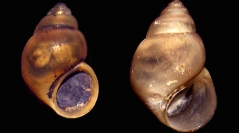

 European Journal of Taxonomy
2019 (524) - Pages 1-15
European Journal of Taxonomy
2019 (524) - Pages 1-15Walter Biese described Littoridina santiagensis Biese, 1944 (Cochliopidae) from Estero Dehesa in 1944 based exclusively on external shell features and a second allopatric population in Yeso Spring three years later. Since 2011 different samplings have been carried out at the type locality and have only provided specimens of the morphologically similar invasive mudsnail Potamopyrgus antipodarum Gray, 1843 (Tateidae), raising doubts about the identity of the species. The recent finding of two snail morphotypes in Yeso Spring, a thick shelled form congruent with type specimens of L. santiagensis and a slender one morphologically associable to P. antipodarum, allowed comparative studies, including the taxonomic analysis of additional populations with similar shell morphology occurring in central Chile. A DNA barcoding (COI) approach identified the slender form from Yeso Spring in Maipo Basin and a second population from the contiguous Rapel Basin indeed as the invasive P. antipodarum; however, L. santiagensis was recovered among species of Potamolithus Pilsbry, 1896 (Tateidae), justifying the Potamolithus santiagensis (Biese, 1944) comb. nov. Besides recognition of three other populations as belonging to Potamolithus, the molecular analysis also suggests trans-Andean dispersal of this group of snails in the Southern Cone of South America.
Cryptic species, freshwater snails, Cochliopidae, new combination, Tateidae.